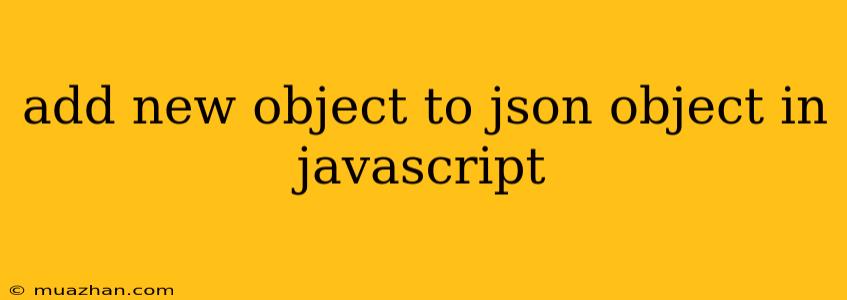Adding New Objects to a JSON Object in JavaScript
JSON (JavaScript Object Notation) is a lightweight data-interchange format that is widely used in web applications. Often, you'll need to add new objects to existing JSON data. This article will guide you through the process of adding new objects to a JSON object in JavaScript.
Understanding the Basics
JSON objects are represented as key-value pairs. The keys are strings and the values can be various data types such as strings, numbers, booleans, arrays, or other JSON objects.
Here's a simple example of a JSON object:
{
"name": "John Doe",
"age": 30,
"city": "New York"
}
To add a new object to this JSON, we can use the following methods:
1. Using the Bracket Notation
The bracket notation provides a straightforward way to access and modify properties within a JSON object.
const person = {
"name": "John Doe",
"age": 30,
"city": "New York"
};
// Add a new property called "occupation"
person["occupation"] = "Software Engineer";
console.log(person);
// Output: { "name": "John Doe", "age": 30, "city": "New York", "occupation": "Software Engineer" }
2. Using the Dot Notation
The dot notation is another common way to interact with JSON objects.
const person = {
"name": "John Doe",
"age": 30,
"city": "New York"
};
// Add a new property called "interests"
person.interests = ["coding", "music", "travel"];
console.log(person);
// Output: { "name": "John Doe", "age": 30, "city": "New York", "interests": ["coding", "music", "travel"] }
3. Using Object.assign()
Object.assign() allows you to merge properties from one or more source objects into a target object.
const person = {
"name": "John Doe",
"age": 30,
"city": "New York"
};
const newObject = { "occupation": "Software Engineer" };
Object.assign(person, newObject);
console.log(person);
// Output: { "name": "John Doe", "age": 30, "city": "New York", "occupation": "Software Engineer" }
4. Using Spread Syntax
The spread syntax is a concise way to add properties from one object to another.
const person = {
"name": "John Doe",
"age": 30,
"city": "New York"
};
const newObject = { "occupation": "Software Engineer" };
const updatedPerson = { ...person, ...newObject };
console.log(updatedPerson);
// Output: { "name": "John Doe", "age": 30, "city": "New York", "occupation": "Software Engineer" }
Key Points to Remember
- JSON is a data format, not a programming language. You need to use JavaScript to manipulate JSON objects.
- While the above methods add new properties, they don't change the original JSON object unless explicitly assigned to a new variable.
- Choose the method that best suits your coding style and the specific context of your application.
By understanding these techniques, you can confidently add new objects to your JSON data and leverage the flexibility of this widely used data format.
